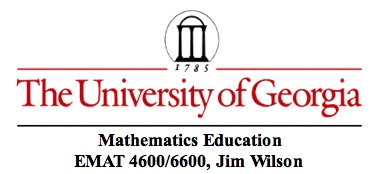
The Problem of Apollonius

The Problem of Apollonius
Who was Apollonius?
The Problem of Apollonius
Problem of Apollonius is to construct a circle tangent to three given circles. The history of mathematics (for example, see Heath (1981, Vol. II, pp. 181-182)) indicates that Apollonius did in fact devote Book II of his treatise to this construction. Apollonius did, however, have a lot of developmental material in Book I. Pappus (Who was Pappus?) was credited with this general statement of the problem:
Given three things, each of which may be either a point, a straight line, or a circle, to draw a circle which shall pass through each of the given points (so far as it is points that are given) and touch the straight lines or circles.
The problem of most interest, of course, is the case where the three objects are circles. Plane geometry methods of the three circle problem usually make use of being able to do simpler constructions such as a circle tangent to two given circles and through a given point. Such was the case of Apollonius in which he built on the work of Euclid (Euclid had presented the constructions for three points and for three lines). Apollonius presented a construction for all of the other cases in Book I before completing the construction for the three circle case in Book II. This was also the approach of Altshiller-Court (1925) where he gave the construction of CCC (Section 355) by reducing it to the construction of PCC (Section 352). The PCC construction was reduced to the PPC construction (Section 351). The development of the entire set of constructions is given in Sections 343 to 355.
The Problem of Apollonius restated:
We will re-phrase this as: To construct a circle tangent to three given objects -- points, lines, or circles.
A point is "tangent to" a circle if it is on the circle.
The problem is posed for "general position" -- that is, objects arranged so that constructions are possible.
There are 10 classes of constructions for this problem.
1. 3 points (PPP)
2. 2 points and 1 line (PPL)
3. 2 points and 1 circle (PPC)
4. 1 point, 1 line, and 1 circle (PLC)
5. 1 point and 2 lines (PLL)
6. 1 point and 2 circles (PCC)
7. 1 line and 2 circles (LCC)
8. 2 lines and 1 circle (LLC)
9. 3 lines (LLL)
10. 3 circles. (CCC)
Generate constructions for items 1 - 9 above.
PPP: Given three points, construct a circle through the three given points. Clear. It is the circle through the three points. Presented by Euclid. The problem has one solution.
PPL: Construct a circle passing through two given points and tangent to a given line. The problem has two solutions, one solution, or not solutions depending on the location of the two pointw with respect to the line..See Angle of View for a problem using this construction.
PPC: Construct a circle passing through two given points and tangent to a given circle. The problem assumes both points are outside the circle or both are inside. It is impossible if one is inside and the other is outside.
PLC: Construct a circle passing through a given point and tangent to a given line and a given circle. (Hint: Reduce the problem to PPL). Four solutions.
PLL: Constuct a circle tangent to two given lines and passing through a given point. See GSP Lesson 1 for a construction.
PCC: Construct a circle passing through a given point and tangent to two given circles.
LCC: Construct a circle tanget to a given line and two given circles.
LLC: Construct a circle tangent to two given lines and a given circle.
LLL: Construct a circle tangaent to three given lines. Four solutions -- the incircle and the three excircles of the triangle formed by the lines. Consider also the case where two of the lines, or all three, are parallel.
The Main Problem: CCC
Quite often, only the tenth case is mentioned in discussions of the Problem of Apollonius: CCC: Given three circles in general, construct all circles tangent to the given three circles.
If the circles are disjoint, not overlapping, not contained within one another, then the construction should lead to eight circles tangent to the three given circles.
Why?
Return to the EMAT 6600 Page
References:
Altshiller-Court, N. (1925) College Geometry: A Second course in Plane Geometry for Colleges and Normal Schools. Atlanta: Johnson Publishing Company.
Heath, T. (1981) A History of Greek Mathematics. (2 Vols.) New York: Dover Publications.